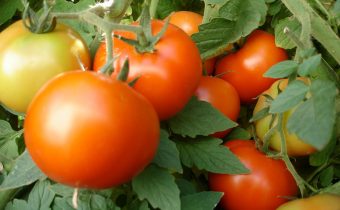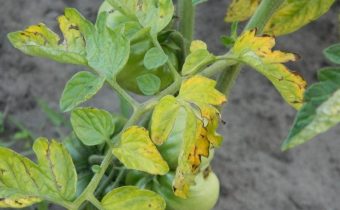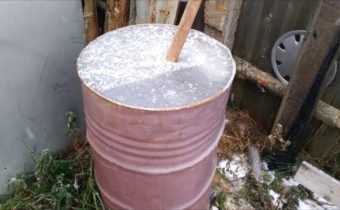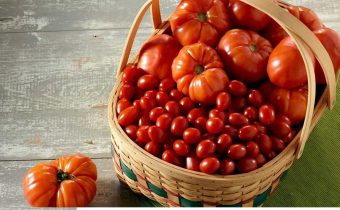How to care for tomatoes in the greenhouse
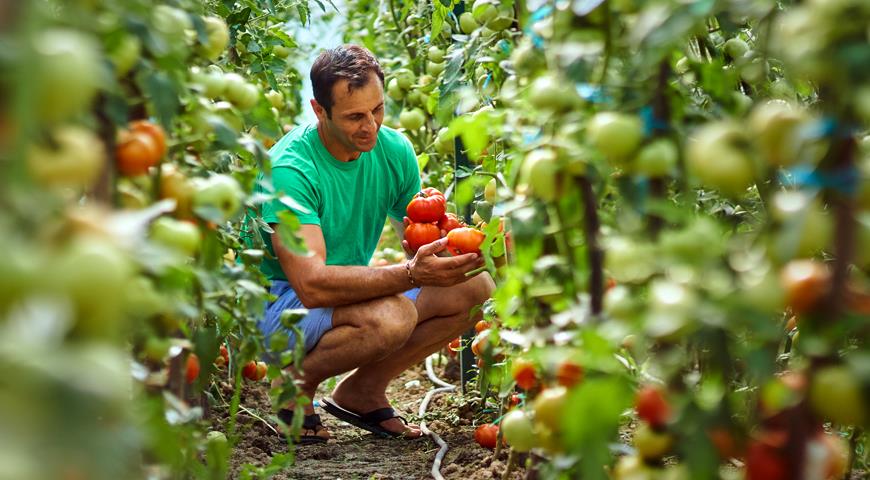
The technology of growing tomatoes in the greenhouse is different from cultivation in the open field. In particular, care in the greenhouse is more demanding for the regime of irrigation, garter and pasynkovanyu, as well as the prevention of diseases of tomatoes.
Being a thermophilic crop, tomatoes are one of the most frequent "tenants" of greenhouses in gardeners of the northern regions. This method of cultivation allows you to protect the plant from the vagaries of changeable spring, to cultivate early varieties or to get fresh fruit all year round.
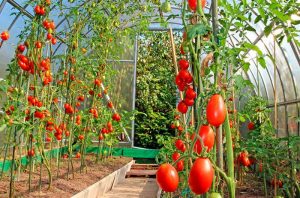 One of the best options is considered to be a polycarbonate greenhouse, due to its durability, high light transmission ability and low heat loss, which makes it possible to save on heating and lighting. The crop in such a shelter ripens earlier than in film analogs, while it is not much more difficult to care for tomatoes after planting in a polycarbonate greenhouse than for plantation on open ground. Nevertheless, care for tomatoes in the greenhouse has some nuances.
One of the best options is considered to be a polycarbonate greenhouse, due to its durability, high light transmission ability and low heat loss, which makes it possible to save on heating and lighting. The crop in such a shelter ripens earlier than in film analogs, while it is not much more difficult to care for tomatoes after planting in a polycarbonate greenhouse than for plantation on open ground. Nevertheless, care for tomatoes in the greenhouse has some nuances.
Watering
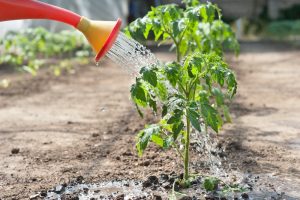 The first thing planted in the greenhouse seedlings need to be watered. Water should be given abundantly, moistening the soil to a depth of 20-25 cm. If tomato seedlings won't get enough moisture immediately after planting, their rooting and development will be slow. Having waited, when the top layer of soil becomes wet, but not wet, it is necessary to carry out loosening. This procedure will ensure the saturation of the roots with oxygen, you need to perform it after each watering.
The first thing planted in the greenhouse seedlings need to be watered. Water should be given abundantly, moistening the soil to a depth of 20-25 cm. If tomato seedlings won't get enough moisture immediately after planting, their rooting and development will be slow. Having waited, when the top layer of soil becomes wet, but not wet, it is necessary to carry out loosening. This procedure will ensure the saturation of the roots with oxygen, you need to perform it after each watering.
To care for tomatoes in the first days after planting in the greenhouse is not required. We need to give the plants time to adapt to new conditions. Only a week later the irrigation is repeated. The frequency of subsequent watering depends on the rate of drying of the top layer of soil. At an early stage of development, tomatoes need frequent watering, because their root system is not sufficiently developed to absorb moisture from deeper layers of soil. On average, it is necessary to moisten the soil every 5 days, consuming 4-5 liters of water per 1m2 landing.
Attention!
Tomatoes, especially young ones, should not be watered with cold water. Its temperature should be around 20-22 ° C.
Irrigation methods
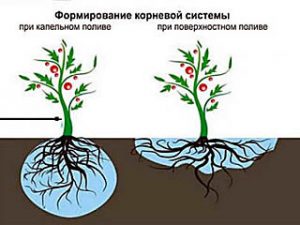 Among irrigation methods, drip irrigation is considered ideal for greenhouses. Sprinkling should not be used even in the case of cultivation on the open field, as wetting the leaves of the plant can cause fungal diseases.
Among irrigation methods, drip irrigation is considered ideal for greenhouses. Sprinkling should not be used even in the case of cultivation on the open field, as wetting the leaves of the plant can cause fungal diseases.
Water under the root can be using a bucket or hose. But, in addition to labor, this method leads to the formation of a solid crust on the soil surface, and a large part of the water evaporates, increasing the humidity of the air in the greenhouse. In this case, 2 hours after watering, the greenhouse needs to be aired.
Drip irrigation does not give intensive evaporation of water, excludes remoistening and drying of the soil. Water is fed under the stem of the plant in small doses in automatic mode. If it is not possible to install a drip irrigation system, you can use the folk trick - stick a plastic bottle with a cut-down bottom near the bush. Water will be supplied immediately under the ground, without forming a crust or evaporating.
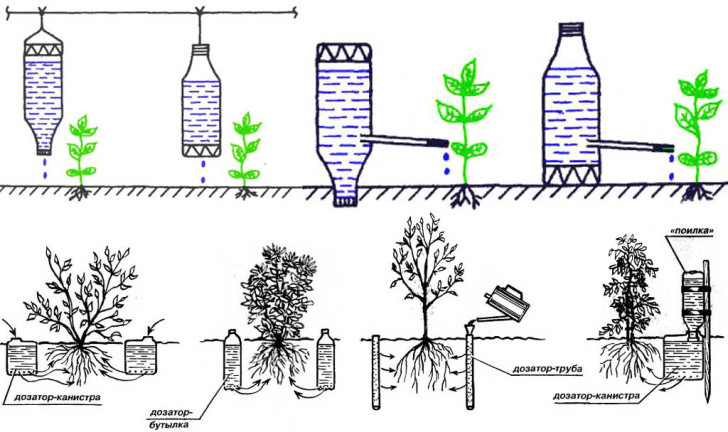
Important!
Regardless of the chosen method of watering the greenhouse needs to be aired. Humidity for the normal development of tomatoes should not be more than 60%.It is advisable to prevent the formation of condensation on the roof and walls of the greenhouse, so that drops of water do not fall on the leaves and flowers of tomatoes.
Forming a bush
Garter
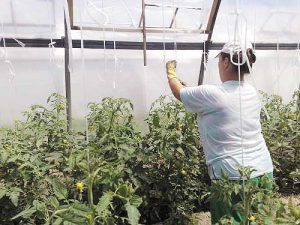 One week after disembarkation bushes of tomatoes need to tie up. This procedure is necessary to ensure the access of fresh air and light to all parts of the plant. If the care of tomatoes is carried out in a polycarbonate greenhouse, the problem with the lack of lighting is less acute than in film greenhouses. Polycarbonate is capable of transmitting up to 85% of sunlight, another question is that in the spring in the northern regions even plants on open ground may not have enough light.
One week after disembarkation bushes of tomatoes need to tie up. This procedure is necessary to ensure the access of fresh air and light to all parts of the plant. If the care of tomatoes is carried out in a polycarbonate greenhouse, the problem with the lack of lighting is less acute than in film greenhouses. Polycarbonate is capable of transmitting up to 85% of sunlight, another question is that in the spring in the northern regions even plants on open ground may not have enough light.
Attention!
Without garter, tomatoes are much more likely to get fungal diseases.
There are 2 ways to garter:
- Each bush is tied with a rope to a separate support (a metal or plastic rod, a wooden stick stuck in the ground).
- Several bushes are tied to a rope (twine, wire) stretched between two supports located at a distance of 1.5-2 meters. As a rule, between the posts they stretch not one, but several ropes at different levels from the ground - this makes it possible to tie up tall varieties of tomatoes, fixing the plant as the stem grows.
The garter rope must be made from natural fibers. Before use, it must be disinfected (for example, by boiling). Do not tie the plant too tightly, pulling the stem, the loop should be sufficiently loose.
Removing stepsons
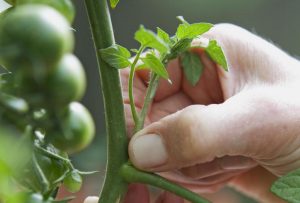 When the seedling develops and is strong, it is necessary regular tomato pasynkovka. It is better to perform the procedure in the morning in dry weather, so that the “wounds” of the plants could drag on during the day. If the weather is wet, you can insure by treating the cut sites with wood ash.
When the seedling develops and is strong, it is necessary regular tomato pasynkovka. It is better to perform the procedure in the morning in dry weather, so that the “wounds” of the plants could drag on during the day. If the weather is wet, you can insure by treating the cut sites with wood ash.
Pasynki zagushchayut plant, contributing to the development of disease and preventing access of light and air to the leaves, as well as take part of the vital juices of the bush. Therefore, to have a good crop of tomatoes, you need to remove your stepchildren during the whole season, not allowing them to grow more than 5 cm. But they should be cut no more than 1 time in 10 days to minimize stress for the plant.
Top dressing
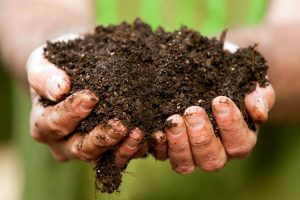 The first dressing you need to makewhen the tomatoes are well accustomed to the new place, about 10-15 days after planting. This will be reflected in the rapid growth and appearance of new leaves on the bush. Before fertilizing plants should be watered.
The first dressing you need to makewhen the tomatoes are well accustomed to the new place, about 10-15 days after planting. This will be reflected in the rapid growth and appearance of new leaves on the bush. Before fertilizing plants should be watered.
For good growth of tomato bushes and a quick set of vegetative mass, it is necessary to apply nitrogen-containing top dressings.
- Manure or bird droppings. 5 kg is poured with water and infused for a week. After that, one part of the mass is diluted with 9 parts of water. Watering with fertilizer is carried out daily, contributing at the root, 1 liter per bush.
- Ammonium nitrate and urea. 1 tablespoon of each component is dissolved in a bucket of water. Bring in the same dosage as manure.
- Green infusion. 1 kg of crushed grass is mixed with a bucket of manure and a glass of wood ash. Mass is poured with 10 liters of water. The solution should be kept in an open barrel in the sun for 7-10 days, after which the fermented liquid is filtered and diluted with water, bringing the volume to 20 liters. Under each bush you need to pour 1 liter of infusion.
The following dressing can be done no earlier than 10 days.
Attention!
When grown in greenhouses, they often use the method of replacing the top layer of soil with more fertile soil. In this case, the first dressing is passed, because an excess of nutrients can be harmful to tomatoes.
Disease prevention
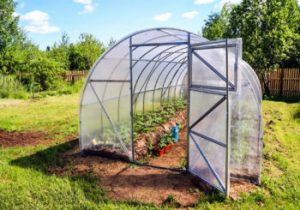 Since tomatoes quickly begin the flowering phase, after which the use of chemicals to combat diseases and pests becomes impossible, it is necessary to carry out preventive treatment of the plant in advance.
Since tomatoes quickly begin the flowering phase, after which the use of chemicals to combat diseases and pests becomes impossible, it is necessary to carry out preventive treatment of the plant in advance.
Protecting tomatoes from fungal diseases in the greenhouse is more difficult than when grown on open ground, because of the more favorable conditions for the development of spores. Therefore, after planting a polycarbonate greenhouse in caring for tomatoes, it is important to observe such rules as airing, controlling air humidity, removing stepsons and tying up.
Late blight - The most common disease of tomatoes, regardless of their growing conditions. In addition to high humidity and heat, the disease is provoked by daily temperature fluctuations - a hot day during a cool night.
Brown leaf spot - the disease occurs mainly in greenhouse tomatoes, except for high humidity, the risk of its appearance increases the lack of lighting.
Another frequent guest in greenhouses is macrosporiosis or dry spotting. Especially intensively the disease develops in heat.
As prevention of fungal diseases use:
- Spraying dairy products (1.5 liters per 10 liters of water). Can be carried out throughout the season with breaks of 10 days.
- Treatment with biologics (for example, "Fitosporin"). These funds destroy the spores of the fungus with the help of bacteria that feed on them, do not belong to chemical preparations and are harmless to the crop.
- Spraying Bordeaux liquid. To do this, a 2% solution of copper sulfate is poured into a 2% solution of hydrated lime of equal volume and the same temperature.
Excess irrigation and fertilizer leads to the defeat of tomatoes with apical and root rot. In a greenhouse, where there is a risk of excessive humidity and rarely good air circulation, gray rot is most likely to occur.
For the prevention of rot should be used:
- Sprinkle with garlic infusion. 400 grams of crushed garlic teeth are poured with warm water and infused for 7 days.
- Treatment with calcium nitrate solution - 40 g of substance should be dissolved in 10 l of water.
- Pollination of bushes with wood ash.
Care during flowering
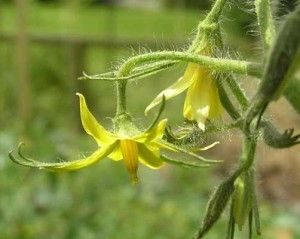 Recommendations for the care of flowering tomatoes:
Recommendations for the care of flowering tomatoes:
- During flowering tomatoes need more water - 10-12 liters per 1m2.
- During this period, it is especially important to deal with excess air humidity, as damp pollen will not be able to fly into the pistil of a flower.
- In the greenhouse, the self-pollination process of tomatoes can also be hampered due to weak air flow. You can help the plants by gently shaking the flowers or stroking them with a soft brush for drawing.
Tip!
To improve the pollination of tomatoes, you can lure bees into the greenhouse by planting honey plants (mint, basil, marigolds) next to it. You can also put at the entrance to the greenhouse a small container of honey, sugar or jam.
- To stimulate fruit set at this time, the bushes can be sprayed with a solution of boric acid (dissolve 5 g of the substance in 10 liters of water).
Top dressing during flowering
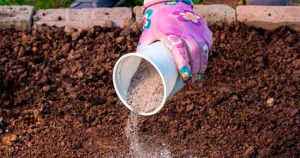 During this period, tomatoes are given potash-phosphorus supplements, using, for example, superphosphate and potassium monophosphate (2 spoons of each substance per bucket of water). The most effective will be foliar feeding, allowing the plant to quickly absorb nutrients. This feeding should be done every 7-10 days.
During this period, tomatoes are given potash-phosphorus supplements, using, for example, superphosphate and potassium monophosphate (2 spoons of each substance per bucket of water). The most effective will be foliar feeding, allowing the plant to quickly absorb nutrients. This feeding should be done every 7-10 days.
As a natural foliar feeding flowering bushes can be sprayed with infusion of nettle. For preparation, take the young leaves and stems of the plant and boil for 5-10 minutes, then allow the broth to infuse.
From root dressings yeast will give a good effect. In a bucket of water you need to dissolve 10 grams of yeast and 2 spoons of sugar.
Ash or milk solution performs the function of not only fertilizers, but also fungicides safe in this phase. 1 kg of ash is poured over with a liter of boiling water and allowed to cool, after which it is diluted with 10 liters of water. 1 liter of sour milk is diluted with 10 liters of water, adding 15 drops of iodine.


